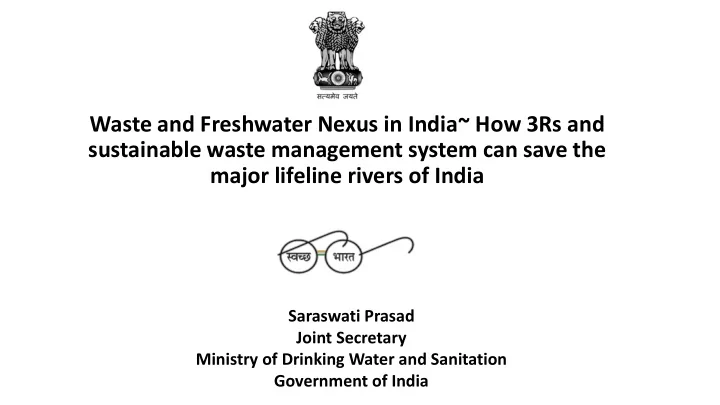

Waste and Freshwater Nexus in India~ How 3Rs and sustainable waste management system can save the major lifeline rivers of India Saraswati Prasad Joint Secretary Ministry of Drinking Water and Sanitation Government of India
Rivers of India • India is also called as the “land of rivers”. • The rivers of India have an important place in the cultural, spiritual and economic lives of Indians. They are lifelines to millions of people. • All major rivers of India originate from one of the three main watersheds: o The Himalaya and the Karakoram ranges . o Vindhya and Satpura ranges and Chotanagpur pl ateau in central India. o Sahyadri or Western Ghats in western India.
Water security and Waste management • A inherent nexus exists between water security and waste management • The type and level of waste management is one of the most important factors influencing the health of our rivers and the water security - quality and quantity of countries • Waste generation can have severe implication for fresh water resources • In India this nexus is severe for the large population living in the river plains. e.g. the Ganga provides water to about 40% of India's population across 11 states, serving an estimated population of 500 million people or more, which is larger than any other river in the world.
Pollution in Rivers • With the large population living on the banks of the rivers, and with many livelihoods depending on the rivers, the extent of pollution (Industrial, Domestic, Agricultural) is high. • CPCB identified 302 polluted river stretches on 275 rivers having higher level of organic pollution assessed on the basis of manual water quality monitoring (data year 2015). • Polluted river stretches have been prioritised based on the organic pollution levels in ambient water.
Number of stretches in each priority class • Priority- I: 34 (BOD more than 30 mg/l) • Priority- II -: 17 (BOD between 30 and 20 mg/l) • Priority- III:36 ( BOD between 20 and 10 mg/l) • Priority- IV:57 (BOD between 10 and 6 mg/l) • Priority- V-158 (BOD between 6 and 3 mg/l)
Polluted riverine length • Total Riverine Length -45000 km. • Estimated Polluted Riverine Length- 12,363 Km • Priority I-2726 km • Priority II-1145 km • Priority III-1834 km • Priority IV-2496 km • Priority V-4166 Km
Main sources of river pollution • Point Source -75% Municipal Sewage, 25% Industrial pollution • Non point sources (i) Open defecation (ii) Run off from Solid & Medical waste & Agriculture field (iii) Disposal of dead bodies & Animal & carcasses
Industrial pollution • For 17 Categories of highly polluting Industries, installation of Online effluent monitoring system at the outlet of the effluent treatment plants for measurement of parameters like flow, pH, COD, BOD, TSS etc has been made mandatory.
Status of Wastewater Generation & Treatment in Urban areas Source : As per report “ Inventorization of Sewage Treatment Plants” published by Central Pollution Control Board (CPCB) in the year 2015
Sanitation coverage in rural areas 50 46.05 45 38.81 40 32.7 35 30 25 20 15 10 5 0 Census 2011 Baseline Survey As on 12.8.2015 2012-13
Major initiatives in India The Swachh Bharat Mission
Swachh Bharat Mission(SBM) • NEW scheme Swachh Bharat Mission (Clean India Mission) launched on 2nd October 2014 by the Hon’ble Prime Minister of India • In SBM, two verticals – Swachh Bharat Mission (Urban) & Swachh Bharat Mission (Rural)
Goals of Swachh Bharat Mission • To make India Open Defecation Free (ODF) India by 2019, by providing access to toilet facilities to all; • To make arrangements for proper Management of Solid and Liquid Waste.
Key components of SBM • Assistance to households for building toilets. • Assistance to Urban Local Bodies/ Rural Local Bodies communities for setting-up and managing Solid and Liquid Waste Management Projects. • Emphasis on behavior change • Community-based collective behavior change suggested as the preferred approach • Guidelines provide flexibility to the States
Initiative specific to Urban areas The Ministry of Urban Development has launched two Missions besides Swachh Bharat Mission (Urban) to provide financial assistance for water supply and sewerage facilities. (i) Atal Mission for Rejuvenation and Urban Transformation (AMRUT) for 500 Class-I cities including State Capitals (ii) Mission for Smart Cities for 100 cities
THANK YOU
Recommend
More recommend